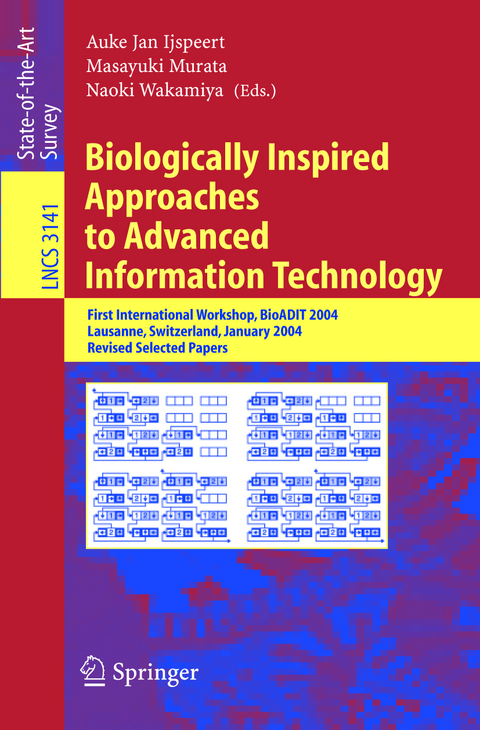
Biologically Inspired Approaches to Advanced Information Technology
Springer Berlin (Verlag)
978-3-540-23339-8 (ISBN)
Biosystems for IT Evolution.- Object-Oriented Specification of Complex Bio-computing Processes: A Case Study of a Network of Proteolytic Enzymes.- Analysis of Responses of Complex Bionetworks to Changes in Environmental Conditions.- Experimental Molecular Evolution Showing Flexibility of Fitness Leading to Coexistence and Diversification in Biological System.- Echo State Networks and Self-Prediction.- Learning Bayesian Networks by Lamarckian Genetic Algorithm and Its Application to Yeast Cell-Cycle Gene Network Reconstruction from Time-Series Microarray Data.- Towards Cortex Sized Attractor ANN.- Bio-inspired Software Systems.- Biologically Inspired Reinforcement Learning: Reward-Based Decomposition for Multi-goal Environments.- Dynamic Self-Assembly and Computation: From Biological to Information Systems.- Implementation and Evaluation of a System to Support Human Relationship Formation in Networked Virtual Space.- Biologically Plausible Speech Recognition with LSTM Neural Nets.- Spatial Tangible User Interfaces for Cognitive Assessment and Training.- Biologically Inspired Computer Virus Detection System.- Explaining Low-Level Brightness-Contrast Illusions Using Disinhibition.- Autonomous Acquisition of the Meaning of Sensory States Through Sensory-Invariance Driven Action.- Hardware Systems.- Characterizing the Firing Properties of an Adaptive Analog VLSI Neuron.- Embryonic Machines That Divide and Differentiate.- Artificial Cellular Division by Self-Inspection.- A Hardware Implementation of a Network of Functional Spiking Neurons with Hebbian Learning.- Robotics.- A Study on Designing Robot Controllers by Using Reinforcement Learning with Evolutionary State Recruitment Strategy.- Movement Generation and Control with Generic Neural Microcircuits.- Efficiency and TaskAllocation in Prey Retrieval.- Anatomy and Physiology of an Artificial Vision Matrix.- Bio-inspired Distributed/Parallel Processing.- An Adaptive Mechanism for Epidemic Communication.- The Blob Division.- Distributed Central Pattern Generator Model for Robotics Application Based on Phase Sensitivity Analysis.- Ant-Based Approach to Mobile Agent Traversal.- Bio-inspired Networking.- An Ant Inspired Technique for Storage Area Network Design.- Media Streaming on P2P Networks with Bio-inspired Cache Replacement Algorithm.- An Artificial Immune System Approach to Misbehavior Detection in Mobile Ad Hoc Networks.- Scalable and Robust Scheme for Data Gathering in Sensor Networks.- Image Processing.- Biologically Inspired Image Compression in Biomedical High-Throughput Screening.- Naïve Algorithms for Keyphrase Extraction and Text Summarization from a Single Document Inspired by the Protein Biosynthesis Process.- Biologically Motivated Trainable Selective Attention Model Using Adaptive Resonance Theory Network.- Other Topics.- Searching for a Practical Evidence of the No Free Lunch Theorems.- How Collective Intelligence Emerge in Complex Environment?.- The Genealogy of Biomimetics: Half a Century's Quest for Dynamic IT.
| Erscheint lt. Verlag | 22.10.2004 |
|---|---|
| Reihe/Serie | Lecture Notes in Computer Science |
| Zusatzinfo | XIV, 516 p. |
| Verlagsort | Berlin |
| Sprache | englisch |
| Maße | 155 x 235 mm |
| Gewicht | 770 g |
| Themenwelt | Informatik ► Software Entwicklung ► User Interfaces (HCI) |
| Mathematik / Informatik ► Informatik ► Theorie / Studium | |
| Schlagworte | Algorithm analysis and problem complexity • Algorithmic Learning • algorithms • Ant Algorithms • artificial immune sys • artificial immune systems • Bayesian Network • Biocomputing • Bioinformatik • bioinspired computing • Biologically Motivated Computing • Evolvable Systems • Genetic algorithms • Hardcover, Softcover / Informatik, EDV/Informatik • HC/Informatik, EDV/Informatik • Image Processing • information system • Intelligence • Natural Computing • peer-to-peer-systems • Replication • Robotic • Robotics • Self-Organization • Self-Repair • Speech Recognition |
| ISBN-10 | 3-540-23339-3 / 3540233393 |
| ISBN-13 | 978-3-540-23339-8 / 9783540233398 |
| Zustand | Neuware |
| Haben Sie eine Frage zum Produkt? |
aus dem Bereich


